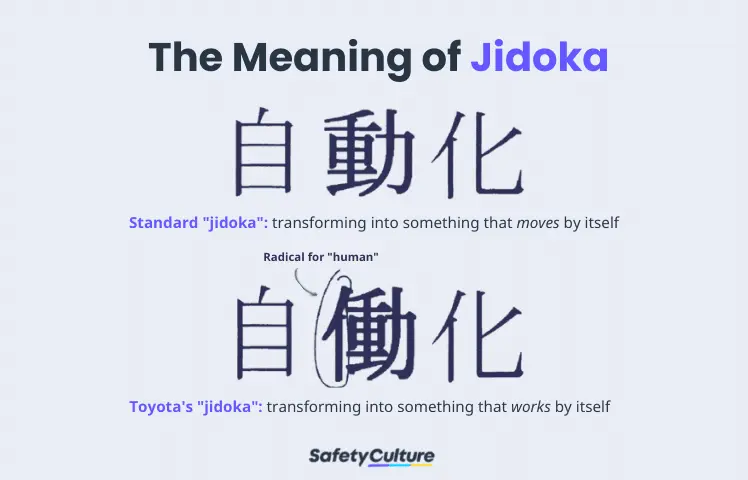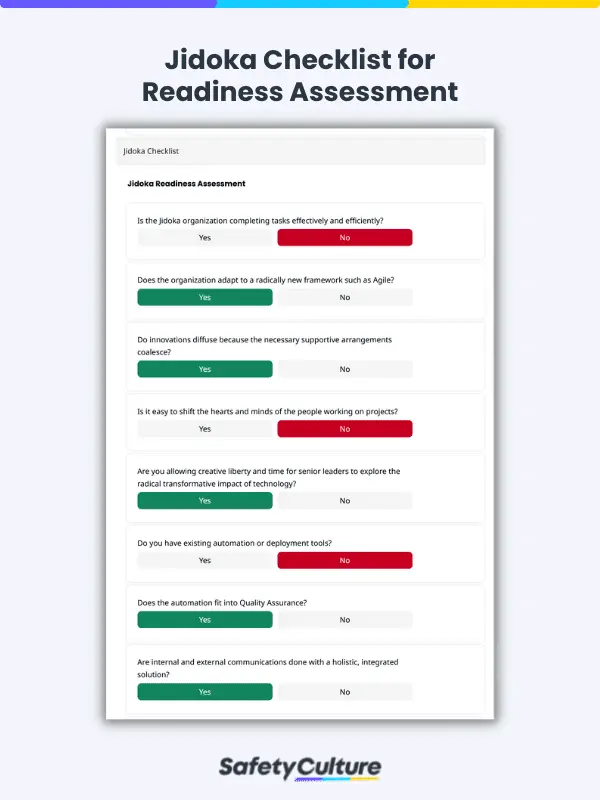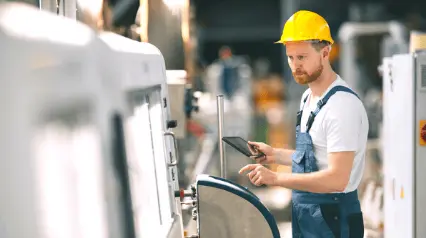What is Jidoka?
Jidoka is a principle implemented in lean manufacturing where machines automatically stop working upon detecting an abnormal condition and operators try fixing the defect to prevent recurrence of the issue. The lean jargon originates from Japanese which translates in English as “autonomation,” a combination of the words autonomous and automation. Literally, Jidoka means automation with a human touch, a key pillar in the Toyota Production System (TPS) which later inspired the House of Lean. The concept of integrating intelligence to machinery makes it easier for a single operator to run multiple machines with minimal effort and for companies to become more profitable as productivity increases.

A Toyota-created word, Jidoka means including the human element in automation. | Image Source
Jidoka Meaning: History and Development
Jidoka in lean is technically a term created by Toyota that is pronounced exactly like the Japanese word for automation (Jidōka), but it is written differently. Because the character for “human being” has been added to the standard spelling, its meaning has changed. Therefore, the definition of Jidoka can be best understood as “autonomation” meaning automation with a human touch, or autonomous automation.
The origin of Jidoka can be traced back to Sakichi Toyoda, the founder of Toyota which started as a textile manufacturing company. In 1896, he developed a mechanism that could detect broken threads in a loom and automatically stop the machine from producing faulty materials. Prior to his invention, looms continued to make defective fabrics when a thread broke, so workers needed to constantly keep an eye on every machine.
As a practical application of the principle of Jidoka, the weft breakage auto-stop device incorporated into the looms shows automation with human intelligence. It provides assets such as equipment the capability to recognize good parts from bad autonomously, or without being closely monitored by employees. Because of this, one operator can handle several machines, resulting in massive productivity gains. Not only can people be freed from being tied to machinery, but they can also be positioned to do more value-adding work in daily business operations.
Over time, the meaning of Jidoka evolved from simply being an automatic stop of processes in case of irregularities to multi-machine handling with semi-automated machines. Michel Baudin in his book Working with Machines: The Nuts and Bolts of Lean Operations with Jidoka even expands the list of generally accepted definitions with “partial automation,” or the automation of hazardous, burdensome, and time-consuming tasks that cause fatigue throughout a shift or repetitive stress injuries in the course of months or years.
However, Jidoka in Toyota means that a machine must come to a safe stop whenever an abnormality occurs. The goal is not to continuously run machines but to automatically stop them from running when a problem arises. This function helps capture flaws from escaping further down the line, prevents avoidable injuries, minimizes property damage, and empowers teams to enact long-term solutions after examinations of the matter.
Why is Jidoka Important?
Jidoka is important because it is one of the two basic pillars of the world’s most significantly adopted production system. Without it, the House of Lean will fall. Putting the principle to action helps businesses ensure the development of high-quality products because defective goods automatically get detected throughout the manufacturing procedure. Jidoka also empowers frontline workers with a mindset that approaches every problem they identify as an opportunity to improve. It sustains a culture of continuous improvement by learning from the flaws in production and applying solutions instantly instead of wasting them through inactivity.
Jidoka Principle: 4 Elements in Lean Manufacturing
Essentially, there are 4 basic elements of the Jidoka principle in lean manufacturing: detection, stoppage, response, and prevention. Having a firm grasp of these fundamental components can provide a clearer understanding of the principle and how it can be applied in the business practices of modern manufacturers:
- Detecting Abnormalities: Every piece of equipment should be installed with the ability to spot mistakes. Moreover, an alert system should be in place to signal the discovery of any abnormality such as product defects, raw material errors, and machine failures.
- Stopping Production: Upon abnormality detection, machines should be able to automatically cease working in order to contain the issue. Operators should also have the means to manually stop production just in case they notice anything substandard.
- Taking Actions: With auto-stop mechanisms that halt production, operators should evaluate the situation and call for assistance when necessary. Corrective actions should be carried out within a given timeframe to decide whether to resume production or not.
- Preventing Recurrence: When quick fixes enable production to go on, managers should retrospectively look into the problem to enforce permanent solutions. When the given time runs out and the issue still persists, a designated team should conduct an investigation to address the root cause and continue production as soon as possible.
How is Jidoka Implemented?
Jidoka requires a company-wide paradigm shift, from overlooking seemingly small issues for the sake of meeting deadlines to taking responsibility for ensuring quality at the source. Wherever an organization lands in that spectrum, one thing remains certain—at the heart of Jidoka is the human. The key to successful implementation is people working together with machines. Generally, there are 3 simple steps to start Jidoka performance in lean manufacturing:
1. Demonstrate Management Commitment
To set manufacturers up for success in administering a lean production system, managers should regard Jidoka with the same level of importance as Just-in-Time (JIT). They often miss out on growth opportunities because of placing too much emphasis on the continuous flow of labor and materials. However, when the management commits to also actualize Jidoka in the context of the organization, a clear definition should be constructed and communicated. Since it is primarily a principle, everyone in the company should be on the same page about exactly what it means, beginning from the top down and continuing from the ground up.
2. Conduct Readiness Assessments
With direction from leadership to transform the way the company operates, use a Jidoka checklist to determine specific implementation needs. Going through readiness assessments with relevant stakeholders can help the organization understand their conditions better and prepare for changes such as adapting to a radically new framework, documenting requirements in detail, and establishing key elements of the Jidoka performance improvement system, including evaluation, organizational learning, and innovation processes, among others.

How to Implement Jidoka: Readiness Assessment | View Checklist
Create Your Own Jidoka Checklist
Eliminate manual tasks and streamline your operations.
Get started for FREE3. Execute Practical Applications
Upon recognizing and filling in implementation gaps, plan and initiate a specific Jidoka project with a cross-functional team. One of the fastest ways to scale it is through Andon, setting up machines or assembly lines with the capacity to surface problems and stop production. As a visual management system, operators can efficiently alert managers about issues so fixes can be made at the onset. Previously, the operator just normally restarts the machine when it stops because of a mistake. With a practical application of Jidoka, staff members can now confidently raise safety or quality concerns and place countermeasures that can prevent recurrence.
Jidoka Examples
One of the most famous examples of Jidoka is the Toyoda Automatic Loom Type G, the perfected version of the 1896 loom which was eventually patented 28 years later. Not only did the 1924 loom possess auto-stop devices, but it also features a non-stop shuttle change motion, where materials can be automatically supplied to the machine without reducing speed during ongoing operation.
Another Jidoka example is the automatic stop function of modern printing machines when papers get jammed. Printers can detect if something weird is going on with their paper supply, stopping the printing process and notifying the user about the error. Once the paper jam gets cleared, the print recommences while averting damages to its quality and the printer itself.
Upholding Jidoka with Today’s Technology
While the concept of Jidoka has been around for more than a century, its manifestation has multiplied through the fourth industrial revolution, or Industry 4.0. Undoubtedly, there has been a growing trend for the automation of industrial operations through smart manufacturing technologies. SafetyCulture (formerly iAuditor) is an operations management platform that can help teams respond to issues faster and work better together. Here’s how SafetyCulture can help organizations uphold the Jidoka principle:
Report, Manage, and Document Issues More Efficiently
Take issues reporting to the next level through the SafetyCulture Issues feature. With the mobile app, capture key information as soon as production stops, so your team can handle safety or quality concerns before they get out of hand. Using the web app, manage reported issues and ongoing investigations efficiently as you access their status and updates from a user-friendly dashboard. Managers can ensure that all issues identified through Jidoka applications are properly documented and accounted for. Also, workers can be trained on timely reporting and issues management to be aligned with organizational standards.
Assign, Monitor, and Keep Records of Actions More Effectively
Initiate a culture of teamwork, communication, and collaboration through the SafetyCulture Actions feature. Displayed in a timeline that looks like a conversation, teams can chat and attach photos to corrective actions or applied fixes and implemented solutions with priority levels and due dates. Logging in to SafetyCulture on desktops or laptops enables you to view all assigned actions in easy-to-understand charts to help track areas of improvement and keep compliance records.
Add up to 10 team members with a free SafetyCulture account today!




